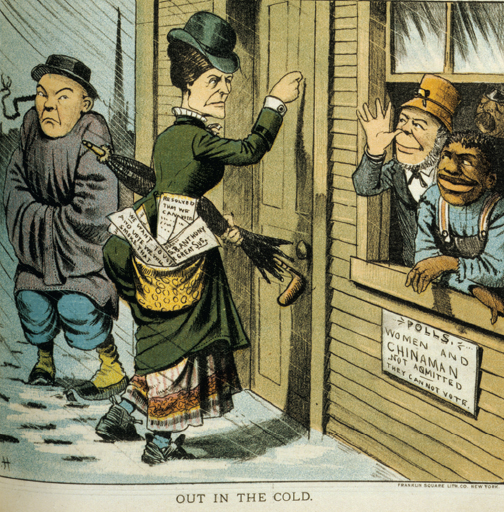America’s History: Printed Page 485
America: A Concise History: Printed Page 445
America’s History: Value Edition: Printed Page 428
Woman Suffrage Denied
Passage of the Fifteenth Amendment was a bittersweet victory for one group of Union loyalists: women. Some formerly enslaved women believed they would win voting rights along with their men, until northern allies corrected that impression. National women’s rights leaders, who had campaigned for the ballot since the Seneca Falls convention of 1848, hoped to secure voting rights for women and African American men at the same time. As Elizabeth Cady Stanton put it, women could “avail ourselves of the strong arm and the blue uniform of the black soldier to walk in by his side.” The protected categories for voting in the Fifteenth Amendment could have read “race, color, sex, or previous condition of servitude.” But that word proved impossible to obtain.

Enfranchising black men had clear benefits for the authors of Reconstruction. It punished ex-Confederates and ensured Republican support in the South. But women’s partisan loyalties were not so clear, and a substantial majority of northern voters — all men, of course — opposed women’s enfranchisement. Even Radicals feared that this “side issue” would overburden their program. Influential abolitionists such as Wendell Philips refused to campaign for women’s suffrage, fearing it would detract from the focus on black men. Philips criticized women’s leaders for being “selfish.” “Do you believe,” Stanton hotly replied, “the African race is entirely composed of males?”
By May 1869, the former allies were at an impasse. At a convention of the Equal Rights Association, black abolitionist and women’s rights advocate Frederick Douglass pleaded for white women to consider the situation in the South and allow black male suffrage to take priority. “When women, because they are women, are hunted down, … dragged from their homes and hung upon lamp posts,” Douglass said, “then they will have an urgency to obtain the ballot equal to our own.” Some women’s suffrage leaders joined Douglass in backing the Fifteenth Amendment without the word sex. But many, especially white women, rejected Douglass’s plea. One African American woman remarked that they “all go for sex, letting race occupy a minor position.” Embittered, Elizabeth Cady Stanton lashed out against “Patrick and Sambo and Hans and Ung Tung,” maligning uneducated freedmen and immigrants who could vote while educated white women could not. Douglass’s resolution in support of the Fifteenth Amendment failed, and the convention broke up.
At this searing moment, a rift opened in the women’s movement. The majority, led by Lucy Stone, reconciled themselves to disappointment. Organized into the American Woman Suffrage Association, they remained loyal to the Republican Party in hopes that once Reconstruction had been settled, it would be women’s turn. A group led by Elizabeth Cady Stanton and Susan B. Anthony struck out in a new direction. They saw that, once the Reconstruction Amendments had passed, women’s suffrage was unlikely in the near future. Stanton declared that woman “must not put her trust in man.” The new organization she headed, the National Woman Suffrage Association (NWSA), focused exclusively on women’s rights and took up the battle for a federal suffrage amendment.
In 1873, NWSA members decided to test the new constitutional amendments. Suffragists all over the United States, including some black women in the South, tried to register and vote. Most were turned away. In an ensuing lawsuit, suffrage advocate Virginia Minor of Missouri argued that the registrar who denied her a ballot had violated her rights under the Fourteenth Amendment. In Minor v. Happersett (1875), the Supreme Court dashed such hopes. It ruled that suffrage rights were not inherent in citizenship; women were citizens, but state legislatures could deny women the vote if they wished.
Despite these defeats, Radical Reconstruction had created the conditions for a nationwide women’s rights movement. Some argued for suffrage as part of a broader expansion of democracy. Others, on the contrary, saw white women’s votes as a possible counterweight to the votes of African American or Chinese men (while opponents pointed out that black and immigrant women would likely be enfranchised, too). When Wyoming Territory gave women full voting rights in 1869, its governor received telegrams of congratulation from around the world. Afterward, contrary to dire predictions, female voters in Wyoming did not appear to neglect their homes, abandon their children, or otherwise “unsex” themselves. Women’s suffrage could no longer be dismissed as the absurd notion of a tiny minority. It had become a serious issue for national debate.
UNDERSTAND POINTS OF VIEW
Question
Abolitionists and women’s suffrage advocates were generally close allies before 1865. What divisions emerged during Reconstruction and why?